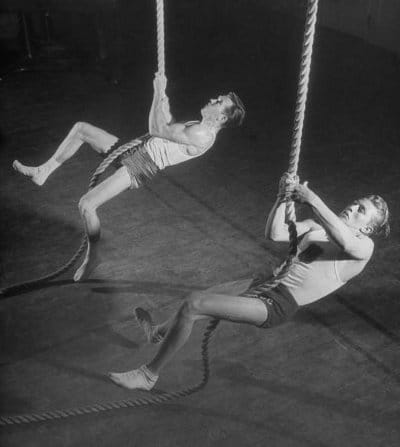
One of my sheepdog goals this year is to become proficient with a handgun and to get my carry license.
I bought my first handgun a few months ago — a Smith & Wesson M&P 9mm — and have been taking defensive handgun classes at the U.S. Shooting Academy. One thing I quickly discovered is that firearm training gets really expensive, really fast. First there’s the range time you need to pay for, but what really kills you is the ammo. Holy smokes, that stuff was like gold for awhile. I saw places selling 9mm ammo for $1.50 a round. Sheesh. While ammo prices are beginning to drop as producers catch up with the demand, you’ll still need to fork over a pretty penny for a day at the range.
At one of my classes I overheard some guys talking about how they were using airsoft guns in addition to their live and dry fire training.
“Airsoft guns? Isn’t that what little kids play with?” I asked with some skepticism.
You see, up until that point my only experience with airsoft guns was watching neighborhood kids run around with their neon orange space ray toy guns and plink each other with plastic BBs.
One of the crusty old-timers responded, “Hell yeah, partner. They’ve gotten real sophisticated in recent years — to the point they have exact replicas of almost every real firearm on the market. I’ve got an airsoft version of my Glock. It even simulates recoil when you fire it. Shooting plastic BBs is a hell of a lot cheaper than shooting live ammo. Plus, I can fire it at my house in my garage. It’s been an invaluable tool in improving my gun manipulation.”
He went on to explain that police departments and even the military are using what used to be a kid’s toy as part of their firearm training. Still dubious, I started doing some research, and I’ll be darned if the old guy wasn’t right. Airsoft guns have gotten incredibly realistic in recent years. If it weren’t for the orange tip that’s required on them, you couldn’t tell the difference between a real gun and the airsoft version of it. He was also right about how military and police forces around the world are using airsoft guns to train recruits. What’s more, many of the top gun instructors across the country are encouraging their students to include airsoft training along with live fire and dry fire training. I also discovered there’s a HUGE airsoft community offline and online. Instead of shooting each other with paintball guns, people are getting together for massive airsoft matches that pretty much replicate real-life military scenarios.
Intrigued by what I read, I went online to some Asian website and bought the airsoft version of my Smith and Wesson M&P 9mm so I could give it a try. I also started researching as much as I could and talking to experts about airsoft and how you can use airsoft guns in tactical training. Below I share what I’ve learned.
Types of Airsoft Guns
There are three types of airsoft guns, each with their pros and cons. The type of airsoft gun you get depends on how you plan on using it.
Spring Action

Spring action airsoft shotgun
These are the airsoft guns that I was familiar with before my conversation at the gun range. You can find spring action airsoft guns in the toy section of nearly every big box store. To fire the gun, you simply pull the spring back with a lever until it locks in place. When you pull the trigger, the spring releases and pushes a piston forward in an enclosed cylinder in the gun. The piston pushes air out at a high speed which causes the BB to fire out of the barrel.
Spring action guns are cheap (starting prices are $12, although high-end spring action guns can cost upwards of $80), but they have considerable drawbacks. The big one is a slow rate of fire. Every time you want to fire the gun, you have to pull back and cock the spring. I guess that’s not a problem if you’re training to use a bolt-action rifle or a shotgun, but if your real-life gun is a semi-automatic weapon, having to cock every time you fire ruins the simulation. Another drawback is the quality of the guns. Most spring action guns are poorly made with chintzy plastic and feel like toys in your hands. No good if you’re wanting to simulate your real gun.
Automatic Electric Guns (AEGs)
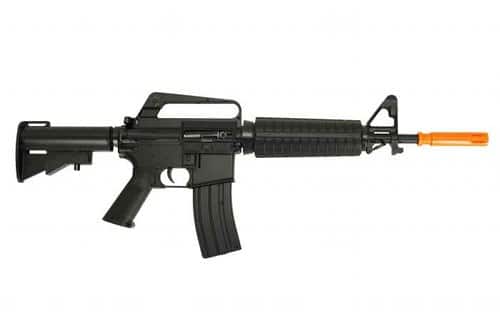
AR-15 Automatic Electric Gun
A more suitable type of airsoft gun for tactical training is the automatic electric gun, or AEG. AEGs have a rechargeable battery that powers a small motor that turns a bunch of gears. These gears pull back and release a piston which causes air to be blasted out at a high-rate. The air propels the pellet out of the gun and towards the target.
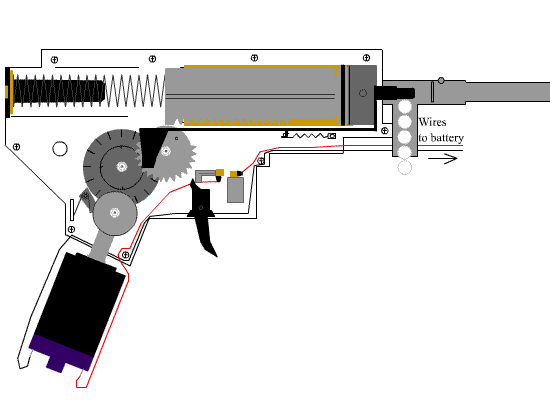
Animated example of how an AEG gearbox works. Source Wikipedia.
Most airsoft semi-automatic rifles and machine guns are AEGs, though you can find AEG handguns as well. AEGs are the most popular airsoft gun among folks taking part in organized airsoft skirmishes.
The biggest advantage AEGs have over spring action airsoft guns is that you can achieve automatic or semi-automatic firing rates with them. You don’t have to cock anything to fire. Just pull the trigger and PEW! a 6mm plastic pellet leaves your gun. Higher-end AEGs are typically exact replicas of their real-life counterparts and are made of both plastic and metal parts. You can even add tactical accessories from your real gun to your airsoft version. Some AEG rifles even provide simulated recoil. Because of the 1:1 realism of high-end AEGs, they’re a great tool to practice weapon manipulation. Many police and military units are using AEG rifles for training.
From a tactical training standpoint, the biggest disadvantage of AEGs is the trigger pull. With most AEGs, the trigger doesn’t break. Instead, the trigger on an AEG acts like a switch that completes a circuit. Thus, you don’t experience that “wall” like you would with a real gun. Depending on the type of AEG, you might also miss out on the simulated recoil.
Gas
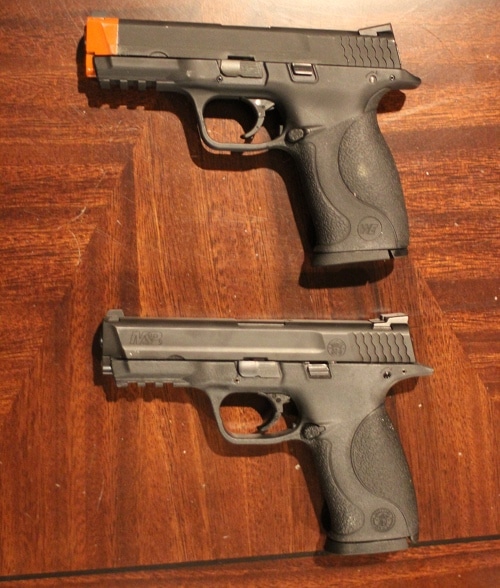
Airosoft gun on top; real gun on bottom. Not much of a difference, huh?
Gas airsoft guns use some sort of compressed gas to propel the pellet out of the gun. You’ll usually find gas-firing mechanisms on pistols and sidearms, though you can find gas-powered rifles too. Many gas-powered airsoft pistols have a blow-back feature which causes the slide on your pistol to reciprocate when you fire it — just like a real gun. You even get a bit of recoil.

On gas-powered airsoft handguns, the gas is kept in the magazine. You inject the gas in the bottom as seen in the picture above.
Gas blow-back airsoft pistols can be an invaluable tool in your handgun training as they provide a nearly identical experience to using your real gun. They’re typically 1:1 replicas of your sidearm. You can even put real handgun parts like sights or tactical lights onto your airsoft version. I was amazed that my airsoft Smith & Wesson weighed about the same as my real S&W. Granted, it’s not exactly the same as live fire training, but it’s pretty darn close. One thing I’ve noticed on my gas blow-back M&P is that there isn’t much slack in the trigger. I hardly have to squeeze the trigger for the gun to fire. I’m sure I could tweak the trigger a bit so it pulls more like my real gun.
If you’re wanting to use airsoft to supplement your handgun training, definitely get a gas blow-back (GBB) version. They’re pricier than non-GBB, but the added simulation is worth it in my opinion. To find where to buy an airsoft version of your real handgun, just Google “Glock 17 airsoft” or “Smith & Wesson MP airsoft.” You’ll find plenty of online stores that sell an airsoft version of your gun. I bought mine from this site. It was the only place I could find it. They’re based in Hong Kong (airsoft is huge in Asia) so I had to pay global shipping.
Types of Gas

1.) Propane gas 2.) CO2 cartridge 3.) Green gas
One thing to take into consideration when using a gas-powered airsoft gun is the type of gas you’re going to use as a propellent. There are three types of gas you can use, each with their pros and cons.
- CO2. The big pro with CO2 is power. You can get the pellet to travel at high velocities using CO2. The downside is cost. CO2 cartridges can be expensive and (compared to other gas types) you don’t get many shots out of a single cartridge. On top of the cost of the cartridges, you’ll need to buy a special converter so you can fill your magazine with the gas. Power is also a downside of the CO2. If you buy a cheap-o gun, the power from CO2 gas can break it.
- Propane. Propane gives you a decent amount of power and is much more stable and cheaper than CO2. Just buy a small hand-held propane tank and an airsoft adapter for it and you’ll have access to cheap gas to power your gun. Not only is propane cheaper than CO2, it’s also more accessible. Whenever you run out of propane, just head to a nearby refill station and fill up your tank. With CO2, you have to go to speciality sports stores or order online. The downside of propane is that it’s a dry gas. You’ll need to lubricate your gun with silicone after every firing session.
- Green gas. Green gas is just propane gas with a bit of silicone mixed in. By adding the silicone into the propane, your gun lubes itself when you fire. Pretty convenient. The downside on green gas is it’s expensive. Look to spend $15 a can. You’ll get about a 1,000 shots from a single can. You’re better off just going with propane and spraying your gun with silicone every now and then. Much more affordable that way.
The Ammo
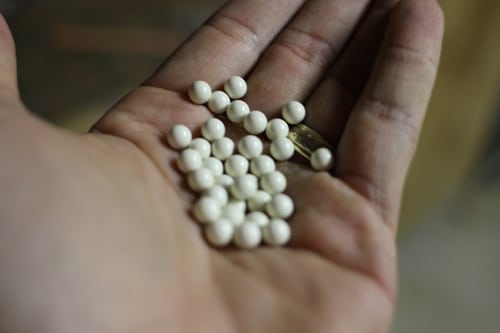
Airsoft guns typically use 6mm plastic pellets. You can fire them at other people (assuming they’re wearing eye protection and are game) and they’ll just feel a sting — almost like getting hit with a paintball.
Pellets are pretty cheap. You can buy a bag of 3,500 rounds for $7 online.
When buying BBs for your airsoft gun, make sure to go for quality. Low-grade BBs can break and shatter when firing, causing irreparable damage to the insides of your gun. Some signs of low-quality BBs include:
- seams
- bubbles
- dimpling
- rough surface
Most big box and sports stores only sell the low-quality stuff.
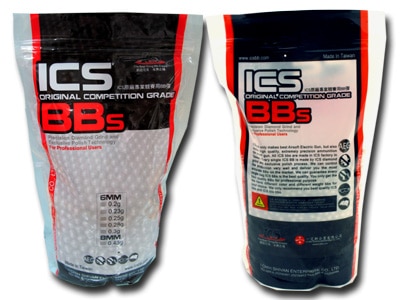
I use ICS BBs during my airsoft training sessions. They’re a good quality pellet: high density, polished, and no seams.
You’ll find high-quality BBs at speciality airsoft stores or online. Quality airsoft BBs are seamless, polished, and high-density. You’ll pay a bit more, but in the long-run it can help save money by avoiding a costly gun replacement. The guys at Airsoft Megastore have a good write up on what happens when you use crappy BBs in your airsoft gun.
Using Airsoft to Supplement Your Firearms Training
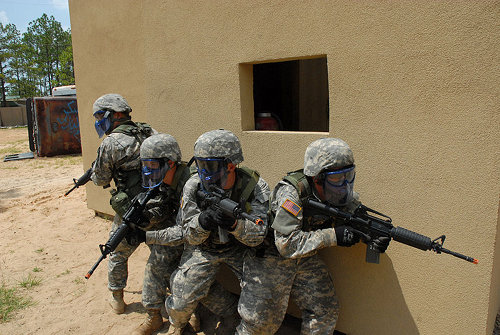
Soldiers with the US Army 187th Ordnance Battalion preparing to clear a room during urban combat training at the battalion’s Field Training Exercise site. The Soldiers were armed with airsoft weapons. Notice the orange tips.
Let’s sum up the benefits and limitations of airsoft guns in your real life handgun training.
Benefits of Airsoft Guns
1:1 replica of your real gun. You can buy airsoft guns that look and feel like your real gun. They’ll fit in your holster. You can also add real-life tactical attachments to them.
Provides near-realistic live-fire experience. Gas blow-back handguns do a good job simulating firing a real handgun. Great for practicing gun manipulation and drawing.
Low cost. This was the big selling point for me. A box of 50 real rounds can set you back $20. I can buy a bag of 3,500 airsoft BBs for $7. The low cost of airsoft allows you to experience a simulated live fire session for a fraction of the cost.
Safe. While you should treat an airsoft gun as if it were a real gun and take the same precautions as you would when practicing, you can rest easy that a BB won’t shoot through your garage wall and kill somebody.
You can do it anywhere. Instead of having to trek 20 miles to the gun range a few times a week, I can go to my garage every evening and practice to my heart’s content.
Provides opportunity for affordable, safe force-on-force training. If you want to practice real, force-on-force tactical scenarios, airsoft can help provide that experience. You can fire it at your buddy pretending to be a bad guy in your house and all he’ll feel is a sting (make sure he’s wearing eye protection though).
Limitations of Airsoft Guns
Not identical to real firearms. Let’s not kid ourselves. While airsoft guns provide a decent simulation of firing a real gun, there’s no way it can replicate it exactly. The trigger pull on airsoft guns aren’t the same as real guns, the recoil is nowhere near the same, and the noise level isn’t the same. You also really can’t practice malfunctions or reloading that well with an airsoft gun. Finally, there’s just a “feeling” you can’t simulate with airsoft. I just feel more alert and on edge when firing a real gun. With good reason — I know that pulling the trigger can have lethal results. I just can’t replicate that feeling when I’m firing my airsoft gun.
Because of this limitation, it’s important that you don’t completely replace live fire training with airsoft. You should continue to get to the range as much as you can to fire your real gun. I like to think of airsoft as a step above dry fire training and a step below live fire. It’s just another tool in your firearm training toolbox.
Airsoft Is Fun Too!
Besides using airsoft as a tactical training tool, it can be a hobby in and of itself. Instead of spending a Saturday with your friends paintballing, you can shoot airsoft guns at each other in the woods. There’s a massive airsoft community out there filled with people who get together for airsoft battles. Tulsa Airsoft even has a huge indoor and outdoor facility for people to take part in airsoft skirmishes. Organized battles often simulate actual military and police scenarios. So you get to have some fun and get a bit of force-on-force training too.
I haven’t taken part in any organized airsoft battles…yet. It’s on my list of things to do, though. Looks like fun. Anybody in the Tulsa area care to join me?
Have you used airsoft in your handgun training? Any other tips for folks looking to supplement their firearms training with airsoft? Share with us in the comments!
Tags: Self-Defense & Fighting





